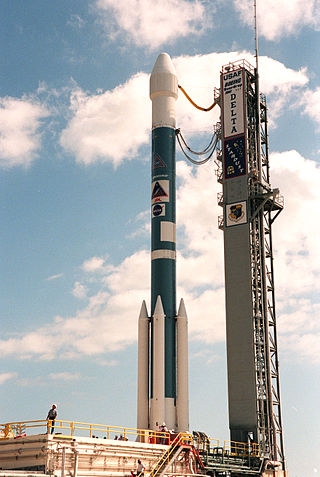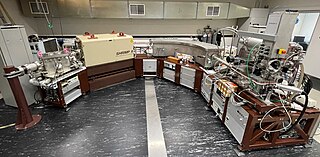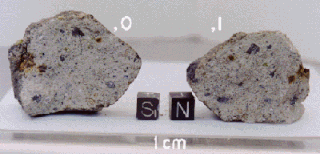Related Research Articles

Presolar grains are interstellar solid matter in the form of tiny solid grains that originated at a time before the Sun was formed. Presolar stardust grains formed within outflowing and cooling gases from earlier presolar stars.

A micrometeorite is a micrometeoroid that has survived entry through the Earth's atmosphere. Usually found on Earth's surface, micrometeorites differ from meteorites in that they are smaller in size, more abundant, and different in composition. The IAU officially defines meteoroids as 30 micrometers to 1 meter; micrometeorites are the small end of the range (~submillimeter). They are a subset of cosmic dust, which also includes the smaller interplanetary dust particles (IDPs).

The sensitive high-resolution ion microprobe is a large-diameter, double-focusing secondary ion mass spectrometer (SIMS) sector instrument that was produced by Australian Scientific Instruments in Canberra, Australia and now has been taken over by Chinese company Dunyi Technology Development Co. (DTDC) in Beijing. Similar to the IMS 1270-1280-1300 large-geometry ion microprobes produced by CAMECA, Gennevilliers, France and like other SIMS instruments, the SHRIMP microprobe bombards a sample under vacuum with a beam of primary ions that sputters secondary ions that are focused, filtered, and measured according to their energy and mass.
Meteoritics is the science that deals with meteors, meteorites, and meteoroids. It is closely connected to cosmochemistry, mineralogy and geochemistry. A specialist who studies meteoritics is known as a meteoriticist.

Troilite is a rare iron sulfide mineral with the simple formula of FeS. It is the iron-rich endmember of the pyrrhotite group. Pyrrhotite has the formula Fe(1-x)S which is iron deficient. As troilite lacks the iron deficiency which gives pyrrhotite its characteristic magnetism, troilite is non-magnetic.

HED meteorites are a clan (subgroup) of achondrite meteorites. HED stands for "howardite–eucrite–diogenite". These achondrites came from a differentiated parent body and experienced extensive igneous processing not much different from the magmatic rocks found on Earth and for this reason they closely resemble terrestrial igneous rocks.

The Lunar Magma Ocean (LMO) is the layer of molten rock that is theorized to have been present on the surface of the Moon. The Lunar Magma Ocean was likely present on the Moon from the time of the Moon's formation to tens or hundreds of millions of years after that time. It is a thermodynamic consequence of the Moon's relatively rapid formation in the aftermath of a giant impact between the proto-Earth and another planetary body. As the Moon accreted from the debris from the giant impact, gravitational potential energy was converted to thermal energy. Due to the rapid accretion of the Moon, thermal energy was trapped since it did not have sufficient time to thermally radiate away energy through the lunar surface. The subsequent thermochemical evolution of the Lunar Magma Ocean explains the Moon's largely anorthositic crust, europium anomaly, and KREEP material.

Extraterrestrial material refers to natural objects now on Earth that originated in outer space. Such materials include cosmic dust and meteorites, as well as samples brought to Earth by sample return missions from the Moon, asteroids and comets, as well as solar wind particles.
CI chondrites, also called C1 chondrites or Ivuna-type carbonaceous chondrites, are a group of rare carbonaceous chondrite, a type of stony meteorite. They are named after the Ivuna meteorite, the type specimen. CI chondrites have been recovered in France, Canada, India, and Tanzania. Their overall chemical composition closely resembles the elemental composition of the Sun, more so than any other type of meteorite.
Tranquillityite is silicate mineral with formula (Fe2+)8Ti3Zr2 Si3O24. It is mostly composed of iron, oxygen, silicon, zirconium and titanium with smaller fractions of yttrium and calcium. It is named after the Mare Tranquillitatis (Sea of Tranquility), the place on the Moon where the rock samples were found during the 1969 Apollo 11 mission. It was the last mineral brought from the Moon which was thought to be unique, with no counterpart on Earth, until it was discovered in Australia in 2011.

Nonmagmatic meteorite is a deprecated term formerly used in meteoritics to describe iron meteorites that were originally thought to have not formed by igneous processes, to differentiate them from the magmatic meteorites, produced by the crystallization of a metal melt. The concept behind this was developed in the 1970s, but it was quickly realized that igneous processes actually play a vital role in the formation of the so-called "nonmagmatic" meteorites. Today, the terms are still sometimes used, but usage is discouraged because of the ambiguous meanings of the terms magmatic and nonmagmatic. The meteorites that were described to be nonmagmatic are now understood to be the product of partial melting and impact events and are grouped with the primitive achondrites and the achondrites.

Meenakshi Wadhwa is a planetary scientist and educator who studies the formation and evolution of the Solar System through the analysis of planetary materials including meteorites, Moon rocks and other extraterrestrial samples returned by spacecraft missions. She is director of the School of Earth and Space Exploration at Arizona State University.
Hypatia is a small stone found in Egypt in 1996. It has been claimed to be both a meteorite and kimberlite debris. It has also been claimed to be the first known specimen of a comet nucleus on Earth, although defying physically-accepted models for hypervelocity processing of organic material. As of November 2023, Hypatia has not been officially classified as a meteorite in the Meteoritical Bulletin, which is tasked with recording all scientifically proven meteorites.
Ernst Kunibert Zinner was an Austrian astrophysicist, known for his pioneering work in the analysis of stardust in the laboratory. He long had a position in the United States at the Laboratory for Space Physics at Washington University in St. Louis, Missouri, where he had earned his doctorate. He came to the United States in the 1960s for graduate work. In addition, Zinner regularly taught at European universities, and other American institutions.
Robert Norman Clayton was a Canadian-American chemist and academic. He was the Enrico Fermi Distinguished Service Professor Emeritus of Chemistry at the University of Chicago. Clayton studied cosmochemistry and held a joint appointment in the university's geophysical sciences department. He was a member of the National Academy of Sciences and was named a fellow of several academic societies, including the Royal Society.

Hadean zircon is the oldest-surviving crustal material from the Earth's earliest geological time period, the Hadean eon, about 4 billion years ago. Zircon is a mineral that is commonly used for radiometric dating because it is highly resistant to chemical changes and appears in the form of small crystals or grains in most igneous and metamorphic host rocks.

Toshiko K. Mayeda was a Japanese American chemist who worked at the Enrico Fermi Institute in the University of Chicago. She worked on climate science and meteorites from 1958 to 2004.
CM chondrites are a group of chondritic meteorites which resemble their type specimen, the Mighei meteorite. The CM is the most commonly recovered group of the 'carbonaceous chondrite' class of meteorites, though all are rarer in collections than ordinary chondrites.
Hafnium–tungsten dating is a geochronological radiometric dating method utilizing the radioactive decay system of hafnium-182 to tungsten-182. The half-life of the system is 8.9±0.1 million years. Today hafnium-182 is an extinct radionuclide, but the hafnium–tungsten radioactive system is useful in studies of the early Solar system since hafnium is lithophilic while tungsten is moderately siderophilic, which allows the system to be used to date the differentiation of a planet's core. It is also useful in determining the formation times of the parent bodies of iron meteorites.
Gas-rich meteorites are meteorites with high levels of primordial gases, such as helium, neon, argon, krypton, xenon and sometimes other elements. Though these gases are present "in virtually all meteorites," the Fayetteville meteorite has ~2,000,000 x10−8 ccSTP/g helium, or ~2% helium by volume equivalent. In comparison, background level is a few ppm.
References
- 1 2 Schmadel, Lutz D. (10 June 2012). Dictionary of Minor Planet Names. Springer. ISBN 9783642297182.
- 1 2 "Caltech Information for students" (PDF). California Institute of Technology. September 1972.
- ↑ "Ghislaine Crozaz webpage". 27 March 2018.
- 1 2 Niebur, Susan (November 2, 2010). "Ghislaine Crozaz - Professor Emerita". NASA Science Solar System Exploration.
- ↑ Crozaz, G.; Picciotto, E.; Breuck, W. De (1964). "Antarctic snow chronology with Pb210". Journal of Geophysical Research. 69 (12): 2597–2604. doi:10.1029/JZ069i012p02597.
- ↑ Picciotto, E.; Crozaz, G.; De Breuck, W. (1964). "Rate of Accumulation of Snow at the South Pole as Determined by Radioactive Measurements". Nature. 203 (4943): 393–394. doi:10.1038/203393a0. ISSN 0028-0836. S2CID 4218313.
- ↑ Crozaz, G.; Langway Jr., C.C (1 July 1966). "Dating Greenland firn-ice cores with Pb-210". Earth and Planetary Science Letters. 1 (4): 194–196. doi:10.1016/0012-821X(66)90067-7.
- ↑ Niebur, Susan (2 November 2010). "November 2, 2020". Women In Planetary Science.
- ↑ Crozaz, G.; Haack, U.; Hair, M.; Hoyt, H.; Kardos, J.; Maurette, M.; Miyajima, M.; Seitz, M.; Sun, S.; Walker, R.; Wittels, M.; Woolum, D. (30 January 1970). "Solid State Studies of the Radiation History of Lunar Samples". Science. 167 (3918): 563–566. doi:10.1126/science.167.3918.563. PMID 17781498. S2CID 45419754.
- 1 2 Jefferson, Brandie (July 18, 2019). "Old rocks, new science: Why Apollo 11 samples are still as relevant as ever". Washington University in St. Louis.
- ↑ "Can We Still Learn Something From Apollo 11 Moon Rocks 40 Years Later? | Science 2.0". www.science20.com. 27 August 2014.
- ↑ Zinner, Ernst; Crozaz, Ghislaine (1986-02-17). "A method for the quantitative measurement of rare earth elements in the ion microprobe". International Journal of Mass Spectrometry and Ion Processes. 69 (1): 17–38. doi:10.1016/0168-1176(86)87039-2. ISSN 0168-1176.
- ↑ Crozaz, Ghislaine; Zinner, Ernst (1 April 1985). "Ion probe determinations of the rare earth concentrations of individual meteoritic phosphate grains". Earth and Planetary Science Letters. 73 (1): 41–52. doi:10.1016/0012-821X(85)90033-0.
- ↑ Wadhwa, Meenakshi; Crozaz, Ghislaine (1995-09-01). "Trace and minor elements in minerals of nakhlites and Chassigny: Clues to their petrogenesis". Geochimica et Cosmochimica Acta. 59 (17): 3629–3645. doi:10.1016/0016-7037(95)00228-R. ISSN 0016-7037.
- ↑ Ghislaine, Crozaz; Floss, Christine; Wadhwa, Meenakshi (15 December 2003). "Chemical alteration and REE mobilization in meteorites from hot and cold deserts". Geochimica et Cosmochimica Acta. 67 (24): 4727–4741. doi:10.1016/j.gca.2003.08.008.
- ↑ Biographical Memoirs: V.86. Washington, D.C.: National Academies Press. 2005-08-15. doi:10.17226/11429. ISBN 978-0-309-09304-0.
- ↑ "Crozaz". Honors Program.
- ↑ "Fellows". meteoritical.org.